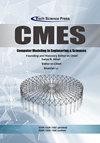Experimental and Numerical Investigation on High-Pressure Centrifugal Pumps: Ultimate Pressure Formulation, Fatigue Life Assessment and Topological Optimization of Discharge Section
IF 2.5
4区 工程技术
Q2 ENGINEERING, MULTIDISCIPLINARY
Cmes-computer Modeling in Engineering & Sciences
Pub Date : 2023-01-01
DOI:10.32604/cmes.2023.030777
引用次数: 0
Abstract
A high percentage of failure in pump elements originates from fatigue. This study focuses on the discharge section behavior, made of ductile iron, under dynamic load. An experimental protocol is established to collect the strain under pressurization and depressurization tests at specific locations. These experimental results are used to formulate the ultimate pressure expression function of the strain and the lateral surface of the discharge section and to validate finite element modeling. Fe-Safe is then used to assess the fatigue life cycle using different types of fatigue criteria (Coffin-Manson, Morrow, Goodman, and Soderberg). When the pressure is under 3000 PSI, pumps have an unlimited service life of 107 cycles, regardless of the criterion. However, for a pressure of 3555 PSI, only the Morrow criterion denotes a significant decrease in fatigue life cycles, as it considers the average stress. The topological optimization is then applied to the most critical pump model (with the lowest fatigue life cycle) to increase its fatigue life. Using the solid isotropic material with a penalization approach, the Abaqus Topology Optimization Module is employed. The goal is to reduce the strain energy density while keeping the volume within bounds. According to the findings, a 5% volume reduction causes the strain energy density to decrease from 1.06 to 0.66 106 J/m3. According to Morrow, the fatigue life cycle at 3,555 PSI is 782,425 longer than the initial 309,742 cycles.高压离心泵的实验与数值研究:极限压力公式、疲劳寿命评估及排气段拓扑优化
泵元件故障的很大一部分是由疲劳引起的。本文主要研究了球铁材料在动载作用下的放电截面性能。建立了在特定位置进行加压和减压试验时的应变采集实验方案。利用这些试验结果,建立了应变与卸料截面侧向面的极限压力表达式函数,并对有限元模型进行了验证。然后使用Fe-Safe使用不同类型的疲劳标准(Coffin-Manson, Morrow, Goodman和Soderberg)来评估疲劳寿命周期。当压力低于3000psi时,泵的无限使用寿命为107次循环,无论标准如何。然而,对于3555 PSI的压力,只有Morrow准则表示疲劳寿命周期显著减少,因为它考虑了平均应力。然后将拓扑优化应用于最关键的泵模型(疲劳寿命周期最低),以提高其疲劳寿命。采用固体各向同性材料和惩罚方法,采用Abaqus拓扑优化模块。目标是降低应变能密度,同时保持体积在一定范围内。结果表明,体积减小5%可使应变能密度从1.06降至0.66 106 J/m3。根据Morrow的说法,3555 PSI的疲劳寿命周期比最初的309742个周期长782425个。
本文章由计算机程序翻译,如有差异,请以英文原文为准。
求助全文
约1分钟内获得全文
求助全文
来源期刊

Cmes-computer Modeling in Engineering & Sciences
ENGINEERING, MULTIDISCIPLINARY-MATHEMATICS, INTERDISCIPLINARY APPLICATIONS
CiteScore
3.80
自引率
16.70%
发文量
298
审稿时长
7.8 months
期刊介绍:
This journal publishes original research papers of reasonable permanent value, in the areas of computational mechanics, computational physics, computational chemistry, and computational biology, pertinent to solids, fluids, gases, biomaterials, and other continua. Various length scales (quantum, nano, micro, meso, and macro), and various time scales ( picoseconds to hours) are of interest. Papers which deal with multi-physics problems, as well as those which deal with the interfaces of mechanics, chemistry, and biology, are particularly encouraged. New computational approaches, and more efficient algorithms, which eventually make near-real-time computations possible, are welcome. Original papers dealing with new methods such as meshless methods, and mesh-reduction methods are sought.
 求助内容:
求助内容: 应助结果提醒方式:
应助结果提醒方式:


